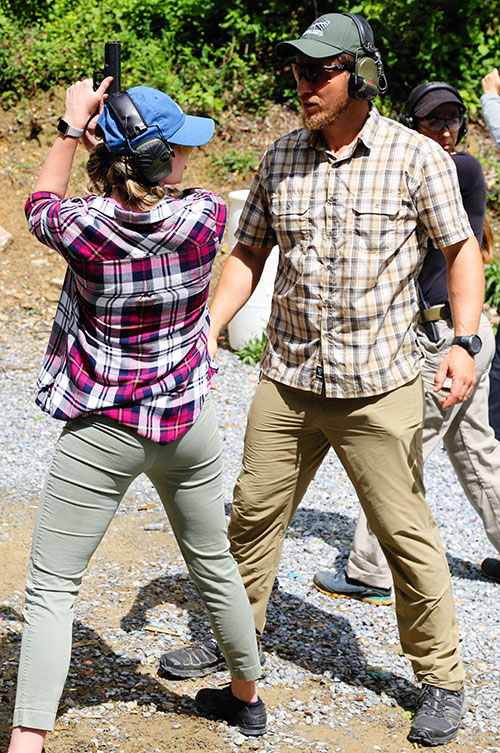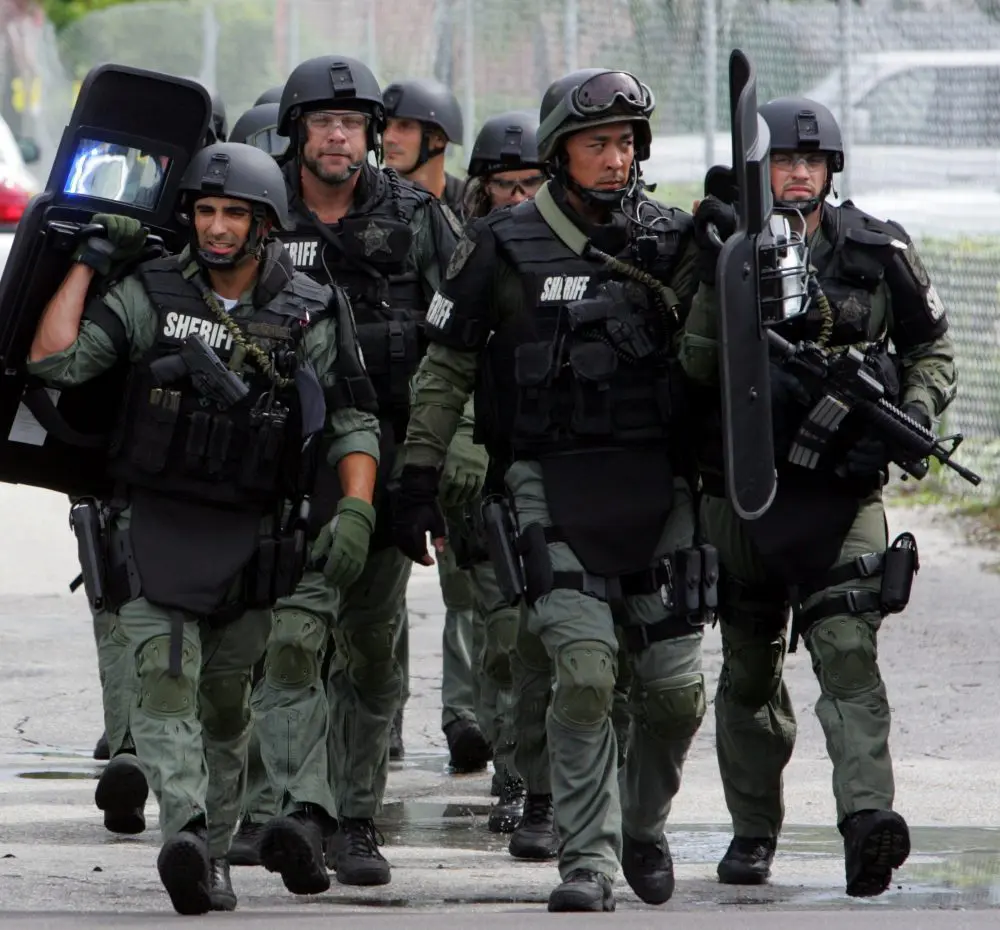
My husband and I were walking on the beach one afternoon when he popped the question: “Would you consider taking a women-only shooting course?” He’s so charming.
Colin had been asking me to use my concealed-carry license for almost four years. Every time I reminded him I wasn’t comfortable assuming so much responsibility. The truth was that I didn’t believe I would be able to use it.
I considered his question for a while and finally said yes. After all, it was just one day. I drove an hour and a half to Milwaukee to attend the Amtac Shooting Women’s Combatives Course taught by Amtac founder Bill Rapier.
I was one of six women ready to sharpen her shooting skills, having been warmly encouraged by her beloved partner. My peers varied in reluctance and experience, but all of us agreed Rapier seemed like a nice guy who knew what he was doing. We were a bit out of touch with his credentials.
Bill Rapier is a recently retired veteran who served 20 years in the Navy. His duties included several years as a member of SEAL Team 3 and over 14 years with Naval Special Warfare Development Group.
After half an hour of girly small talk about chipped nail-polish and our fear of a tick epidemic swarming Wisconsin wild lands, it was time to start. Each of us was assigned a personal station where we stored our weapons, ammunition, first aid, and other belongings during the course.

Rapier then outlined what was ahead: introductory combatives, gun training, knife training, and a mindset talk involving thoughts on safety and personal accountability. Sounded like a good plan.
Before we started, Rapier wanted us to revise our vocabulary. From now on, any item that can be used in self-defense is a “tool.” A gun is a tool. A knife is a tool. A pen is a tool. There are tools all over the place.
Table of Contents
SHOOTING
We walked to our respective shooting positions, each with her own target standing a few feet apart from one another. Rapier reserved the middle target, while we ladies surrounded him with questions and covert fascination. I was already familiar with the basics: safety, grip, pressing the trigger, holstering, and so forth.
I nailed the first two sessions without breaking a sweat. Nice groups, no flinching, made every shot count—except I was cheating a little. I knew I couldn’t rack the slide very well, so I kept pressing the slide release between magazines, while crossing my toes Rapier wouldn’t notice. He noticed. He walked right toward me and said, “All right, let’s see it.”
I replaced my magazine and pressed the slide release. “You have to rack the slide,” he said. “Oh really? I wasn’t aware.” Then, like a toddler, I looked down and confessed I was struggling with it.

took the pistol and demonstrated several techniques that would help me overcome the mighty spring. To my astonishment, I pulled the slide with relative ease—relative.
Ultimately, I completed the drill feeling prouder than ever of my shooting skills. Not only was my performance excellent, I could also manually get that pesky cartridge in the chamber. We were almost done with our gun training—just one segment left.
Rapier asked us to approach the target. Standing only a couple of feet away from the lifelike silhouette, I was horrified to learn we would be firing three shots, single handed, straight from the torso and directly into the center of the target. Rapier demonstrated the exercise a handful of times, making it look ridiculously easy.
Then it was my turn. I froze. I heard the other ladies jump in while I stood there, staring at the deep end, utterly paralyzed.
Previously I was wrapped in the warm security of 15 yards and relatively slow and careful shooting, focusing on accuracy and precision. Now this guy was telling me to be fast and hit anywhere as long as I hit the target.

So once again, I drew Rapier’s attention. “Let’s review the steps together,” he said. “Draw the gun and aim the barrel like so. This far from the body—so it won’t jam—toward that point.” “Got it,” I said sheepishly.
I spent several minutes visualizing the uncomfortable scenarios I might face in the real world and felt my blood pressure rising. Although many women scan their surroundings and take alternate routes home, our greatest fear is close-quarters engagement. A guy grabbing us from behind. An aggressor jumping out of the shadows.
“Go!” I heard Rapier’s voice and went into action. I trusted my training and managed a few hits right in the middle. And for the first time in my life, I knew how to handle the unexpected. This final uncanny exercise turned out to be the most influential in validating my ability to defend myself with a gun.
NON-FIREARMS TOOLS
Next, we put our firearms down and gathered in another area off the firing line, where we learned about reactionary gap, a technique fully exploited by Sayoc Kali practitioners. The term refers to the optimum distance from which one could successfully strike an aggressor without fail, simply because action is inherently faster than reaction.

“It’s like a sucker punch,” Rapier said. “You can knock a guy out, no matter how well trained he is. But you have to knock him out on the first shot. It’s risky, even for girls who can really deliver a powerful punch.” Rapier then picked the training knife up off the table. “But if we place a tool in your hand, you can put a blade in his throat and win every time.”
Trainer in hand, each student spent another half hour practicing various striking patterns within the reactionary gap. It was increasingly unnerving to manipulate a knife and pretend I might take someone’s life in the process of protecting my own.
But it was also necessary. At times, a knife will be the available tool. Other times a gun. According to Rapier, you should use the tool that is most appropriate for a given situation.
MINDSET TALK
Toward the end of the day, we stored our tools and gathered in a small circle. It was time to review what we practiced and the underlying principles that shape them. The mindset talk.
“People will tell you, ‘Just kick him in the crotch and run.’ If this is your only plan, you’re set up for failure,” Rapier said. I looked at my peers and felt the air tighten. “Truth is, most guys are naturally stronger. You need to ask yourself, ‘How do I counter that?’ You use tools. A tool can be anything. A mug you’re holding can easily turn into a powerful impact or projectile weapon. If you’re faced with violence, you do not run to find your gun. You throw hot coffee in his face and then run.”
It was as though I’d been drawn out of my hat by my ears as I realized I carry powerful tools with me every day.

But having tools doesn’t mean I go looking for trouble. According to Rapier, avoidance is ideal because we get to keep our lives without ever using the tools we carry. “It’s like winning without fighting,” he said. I felt like I won a lot by taking this class.
Rapier concluded with the importance of situational awareness and training. In his eyes, regular training is analogous to home or car insurance. While car accidents are common, drivers do not start their day perpetually worried about an impending crash. Instead, they trust they will return home safely as usual, but they take measures in case the worst-case scenario materializes.
Proper firearm and combatives training are even better than insurance—you don’t have to hold on the phone line listening to classical music. Service is instantaneous and aimed at prevention.
As a woman living in fear of violence, I heard Rapier’s words echoing in my mind long after our training was over. Can I really have all this power? Can I take ownership of my own future and safety? Yes. Yes, I can.
ONWARD …
I called Rapier a month later to thank him for his class and to let him know I was now a regular concealed carrier. He was pleased to hear it and encouraged me to continue my training as I become a stronger, more self-reliant woman. I couldn’t help but ask, “Given the success of your women-only courses, why not offer them more frequently?” Rapier laughed and said, “Well, I would consider it, but I’d rather keep my wife happy.”
I have been transformed. While I recognize this class is only an introductory course, it meant a lot to me. I was finally able to understand my husband, and why he wished I had some training. I now intend to continue with more training, to improve and add to the skill-sets I acquired in this class.
SOURCE
AMERICAN TACTICAL SHOOTING INSTRUCTION LLC
www.amtacshooting.com





